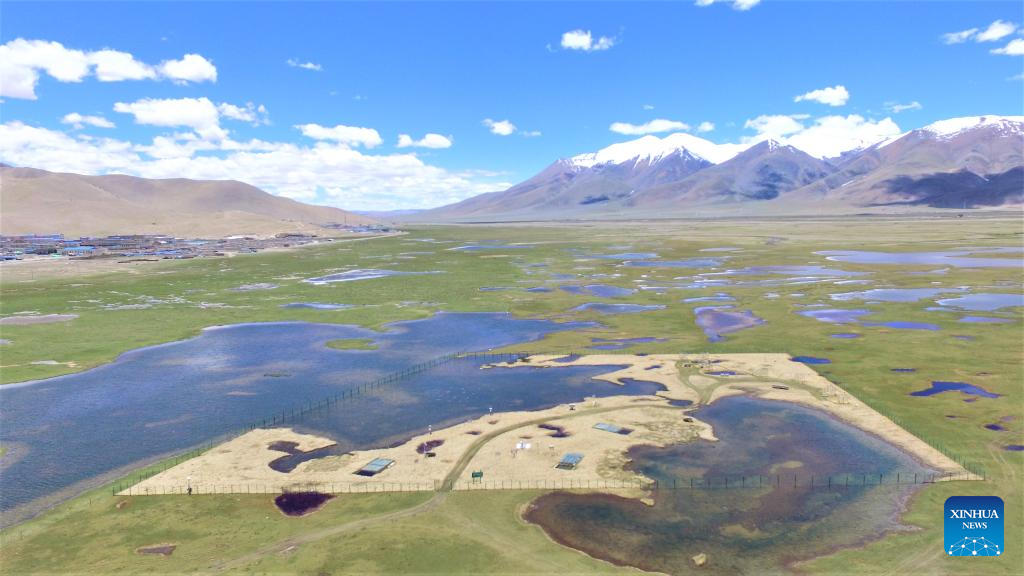

An aerial drone photo taken on June 7, 2021, shows the alpine wetland observation station built by the Institute of Mountain Hazards and Environment (IMHE) of the Chinese Academy of Sciences in Xainza County of Nagqu City, southwest China's Xizang Autonomous Region. (IMHE/Handout via Xinhua)
Despite the global warming and wetting climate, the Qinghai-Xizang Plateau plays an important role as a carbon sink, according to recent studies conducted by the Institute of Mountain Hazards and Environment (IMHE) of the Chinese Academy of Sciences.
The improvement of the carbon sink function of the terrestrial ecosystem in southwest China's Xizang Autonomous Region is an important manifestation of the effectiveness of the ecological security barrier construction and changing climate in the region, said Wei Da, a researcher with the IMHE.
Quantifying the dynamics of carbon sink under climate change and ecological restoration on the Qinghai-Xizang Plateau is one of the priority scientific concerns that urgently need to be addressed, scientists say.
The first demonstration base for carbon sink monitoring of artificial forests in Xizang was established in the city of Shannan this year.
The IMHE also led the construction of the Qinghai-Xizang Plateau terrestrial ecosystem carbon flux observation network, which includes stations in Xainza, Shannan, Yadong, Hoh Xil, Gerze, Zhongba, Madoi, Shuanghu and Serling Co, covering typical alpine ecosystems such as forests, shrubs, meadows, grasslands, wetlands and lakes.
The network synchronously measures carbon flux, water and heat flux, photosynthetically active radiation, air temperature and humidity, soil temperature and humidity and precipitation.
Based on this monitoring network and cooperation with other research organizations, the research team from the IMHE has found that the Qinghai-Xizang Plateau remains an important carbon sink with potential in a warmer and wetter climate.
"We conducted continuous observation at 32 sites and identified the alpine ecosystem as an important carbon sink. Our new discovery shows that as the climate turns warmer and wetter, the alpine plants absorb carbon faster than permafrost releases carbon," said Wang Xiaodan, a researcher with the IMHE.
The Qinghai-Xizang Plateau is the world's largest high-altitude permafrost region, but climate warming may lead to the release of large amounts of permafrost carbon, thereby altering the regional carbon source and sink balance. Scientists have constructed a monitoring data base spanning the plateau and conducted systematic research on this issue.
"We found that 26 sites exhibit significant carbon sink status, with the volume of carbon sink much higher than previously expected. The strongest net carbon sink of the Qinghai-Xizang Plateau occurs at an altitude of about 4,000 meters," said Wei.
"This study has preliminarily drawn a panoramic view of the carbon balance process on the Qinghai-Xizang Plateau. We found that the sustained warming and wetting climate on the plateau will be conducive to plant growth and further enhance the carbon sink," Wei said.
In another study, scientists focus on soil respiration, which is the primary carbon emission process in terrestrial ecosystems, accounting for 60 percent to 90 percent of the total ecosystem respiration and being a key factor in determining the size of the terrestrial carbon sink.
However, there is currently a lack of sufficient data support and scientific understanding regarding the impact of climate change and ecological engineering on deep soil carbon dynamics.
Researchers have established a comprehensive soil carbon process observation system to achieve long-term continuous acquisition of high-resolution data on soil carbon dioxide concentration, water content, temperature and salinity at various depths, which is a crucial approach to uncovering the underground carbon processes in ecosystems, according to Zhang Jianxin, a researcher with the IMHE.
The establishment of the Qinghai-Xizang Plateau carbon flux monitoring network provides an observation and research platform for the plateau, serving as a long-term infrastructure for the dynamic assessment of carbon sink on the plateau, Wei said.
"We plan to increase the number of observation sites in unpopulated regions, eventually forming a comprehensive carbon flux observation network that covers major types of terrestrial ecosystems on the plateau," Wei added. (Xinhua)

86-10-68597521 (day)
86-10-68597289 (night)

86-10-68511095 (day)
86-10-68512458 (night)

cas_en@cas.cn

52 Sanlihe Rd., Xicheng District,
Beijing, China (100864)

